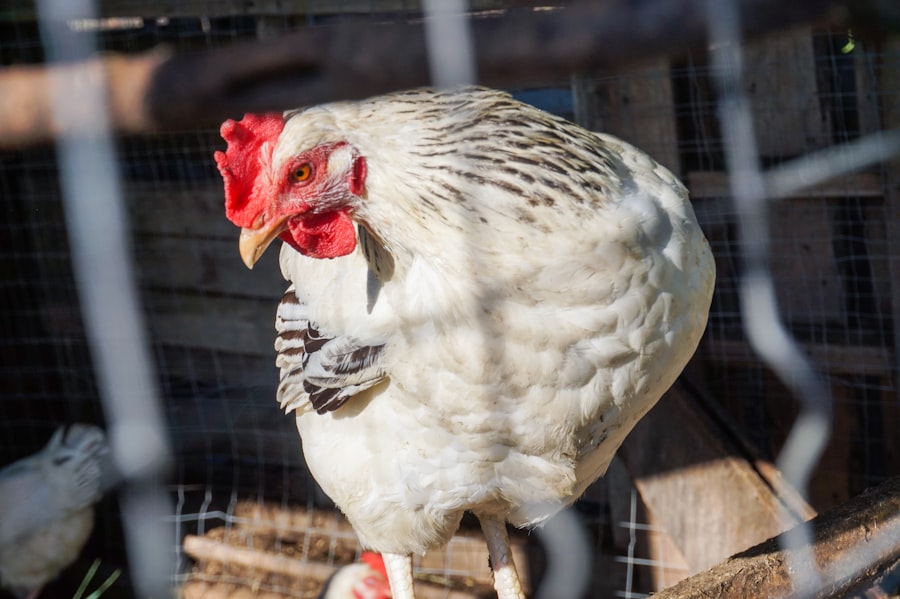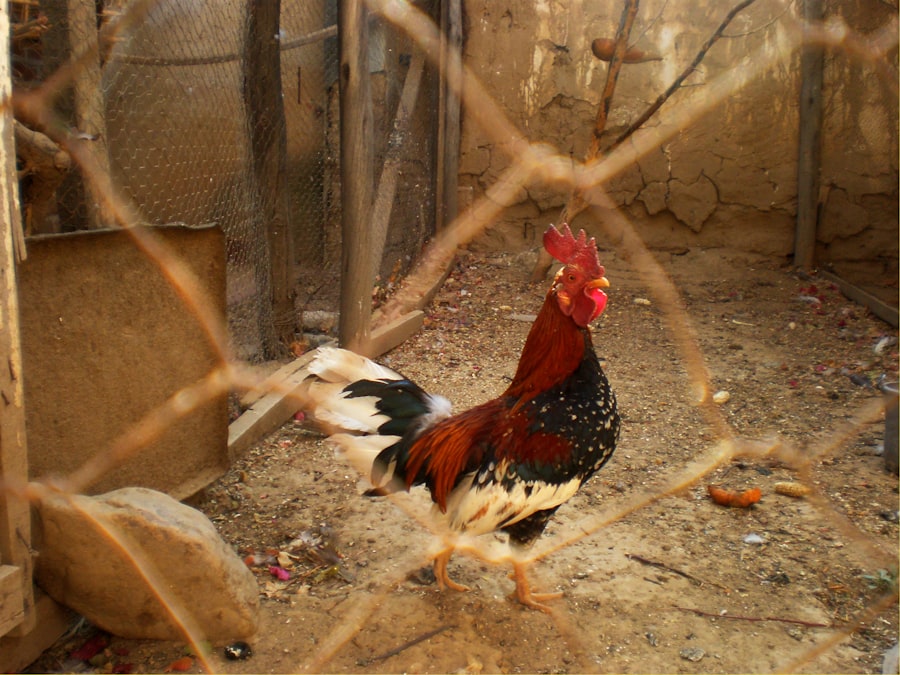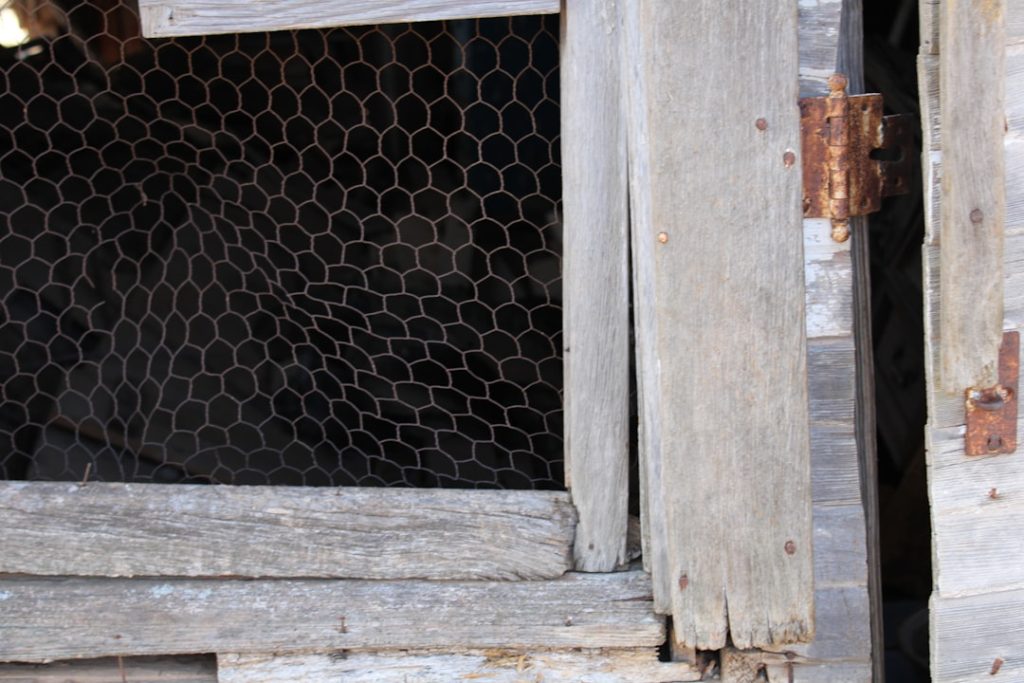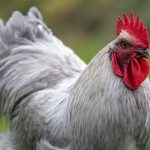Chickens possess a natural ability to fly, rooted in their wild ancestry. In their natural habitat, chickens use flight to evade predators, find safe roosting spots in trees, and explore their environment. This instinct remains present in domesticated chickens, who may attempt to fly when given the opportunity.
Chicken owners should be aware of this behavior to effectively manage their flock and prevent potential issues. Insufficient space or lack of environmental enrichment can lead to restlessness in chickens, prompting them to seek flight opportunities. This behavior may result in escape attempts from coops or runs, potentially exposing chickens to injury or predation risks.
Flying chickens can also cause property damage and disturb neighboring areas. Understanding this instinct allows chicken owners to implement preventive measures and ensure the safety of their birds. Stress and anxiety can also trigger flight attempts in chickens.
Factors such as limited space, exposure to loud noises or sudden movements, and inadequate socialization may contribute to this behavior. Recognizing signs of stress in chickens enables owners to address underlying causes and create a more suitable environment. Comprehending the flight instinct is crucial for providing a safe and stimulating habitat for chickens.
Table of Contents
- 1 Clipping wings
- 2 Providing adequate space and enrichment
- 3 Installing a secure coop and run
- 4 Using deterrents
- 5 Training and socializing chickens
- 6 Regular health and wellness checks
- 7 FAQs
- 7.1 What are some common reasons why chickens fly the coop?
- 7.2 How can I prevent my chickens from flying over the fence?
- 7.3 Are there specific chicken breeds that are less likely to fly?
- 7.4 What are some signs that my chickens are attempting to escape their coop?
- 7.5 How can I make my chicken coop more secure to prevent escapes?
Key Takeaways
- Chickens have a natural instinct to fly, which can lead to escape attempts if not properly managed.
- Clipping wings can help prevent chickens from flying over fences and escaping, but it should be done carefully and only when necessary.
- Providing adequate space and enrichment in the coop and run can help reduce the desire for chickens to escape.
- Installing a secure coop and run with proper fencing and coverings can prevent chickens from escaping and protect them from predators.
- Using deterrents such as visual barriers or noise can help discourage chickens from attempting to escape.
- Training and socializing chickens can help them feel more comfortable and secure in their environment, reducing the likelihood of escape attempts.
- Regular health and wellness checks are important to ensure that chickens are not trying to escape due to stress or illness.
Clipping wings
Importance of Proper Technique
It is crucial to note that wing clipping should only be done by someone who is familiar with the procedure. Cutting the feathers too short can cause pain and discomfort for the bird. When clipping a chicken’s wings, it is essential to only trim the primary feathers on one wing, allowing the bird to maintain its balance while preventing it from achieving lift.
Precautions and Considerations
It is vital to use sharp scissors to ensure a clean cut and minimize any discomfort for the bird. Wing clipping should be done carefully and with caution, as improper technique can cause injury or stress for the chicken. Additionally, wing clipping is not a permanent solution, as the trimmed feathers will eventually molt and regrow, requiring periodic repetition.
A Comprehensive Approach to Managing Flight
While wing clipping can be an effective method for preventing chickens from flying, it is essential to combine it with other measures to prevent flying, such as providing adequate space and enrichment, installing a secure coop and run, and using deterrents. By taking a comprehensive approach, you can ensure the well-being of your chickens while also managing their ability to fly.
Providing adequate space and enrichment

One of the most effective ways to prevent chickens from flying is by providing them with adequate space and enrichment. When chickens are given enough room to roam and explore, they are less likely to feel the need to fly in search of stimulation. Additionally, providing enrichment such as perches, dust baths, and toys can help keep chickens engaged and content, reducing their desire to fly.
Adequate space is essential for keeping chickens happy and healthy. When chickens are overcrowded, they may become stressed and restless, leading them to seek out opportunities to fly. Providing enough space for chickens to move around freely and engage in natural behaviors can help prevent flying and promote overall well-being.
Additionally, offering enrichment such as perches and dust baths can give chickens an outlet for their natural instincts, reducing the likelihood of them attempting to fly. In addition to physical space and enrichment, mental stimulation is also important for preventing flying behavior in chickens. Boredom can lead to restlessness and anxiety, causing chickens to seek out ways to alleviate their discomfort, such as attempting to fly.
Providing toys, puzzles, and other forms of mental enrichment can help keep chickens engaged and content, reducing their desire to fly. Overall, providing adequate space and enrichment is crucial for preventing flying behavior in chickens and promoting their overall welfare.
Installing a secure coop and run
Another important measure for preventing chickens from flying is ensuring that their coop and run are secure. This includes using appropriate fencing and netting to prevent chickens from escaping, as well as making sure that there are no gaps or weak spots that could allow them to get out. Additionally, it is important to regularly inspect the coop and run for any signs of wear or damage that could compromise their security.
When building or maintaining a coop and run, it is important to use materials that are sturdy and durable. This includes using strong fencing that is tall enough to prevent chickens from flying over it, as well as securing any gaps or weak spots that could allow them to escape. Additionally, it is important to regularly inspect the coop and run for any signs of wear or damage that could compromise their security, such as loose boards or rusted wire.
In addition to physical security measures, it is also important to consider the layout of the coop and run in relation to other structures on the property. For example, if there are trees or buildings near the coop that could provide a potential launching point for flying chickens, it may be necessary to make adjustments to prevent them from using these as a means of escape. Overall, installing a secure coop and run is essential for preventing flying behavior in chickens and keeping them safe and contained.
Using deterrents
In addition to physical barriers, there are also various deterrents that can be used to prevent chickens from flying. One common method is using visual deterrents such as shiny objects or scarecrows, which can startle chickens and discourage them from attempting to fly. Another option is using sound deterrents such as wind chimes or motion-activated alarms, which can create a noisy environment that makes flying less appealing for chickens.
Another effective deterrent for preventing flying behavior in chickens is using taste aversion products. These are substances that have a bitter or unpleasant taste, which can be applied to surfaces that chickens may attempt to land on or take off from. When chickens encounter these substances, they are less likely to continue attempting to fly due to the unpleasant experience.
It is important to use taste aversion products that are safe for chickens and do not cause harm or discomfort. It is important to note that while deterrents can be effective in preventing flying behavior in chickens, they should be used in conjunction with other measures such as providing adequate space and enrichment, installing a secure coop and run, and training and socializing chickens. Additionally, it is important to regularly assess the effectiveness of deterrents and make adjustments as needed.
Overall, using deterrents can be a useful tool for managing flying behavior in chickens and keeping them safe and contained.

Building Trust through Handling and Interaction
Spending time with chickens from a young age and handling them regularly can help them become more comfortable with human interaction. This, in turn, makes them less likely to feel the need to escape through flying. Additionally, training chickens to come when called or respond to specific cues can help keep them under control and prevent them from attempting to fly away.
Socializing chickens involves exposing them to different environments, people, and animals in a controlled manner. This helps them become more confident and less likely to feel the need to escape through flying when faced with unfamiliar situations. Socialization can also reduce stress and anxiety, which are common triggers for flying behavior.
Teaching Behaviors to Prevent Flying
Training chickens involves teaching them specific behaviors or commands that can help keep them under control and prevent them from attempting to fly away. For example, owners can train chickens to come when called or respond to specific cues that signal them to return to their coop or run. By consistently reinforcing these behaviors through positive reinforcement techniques such as treats or praise, owners can help keep their chickens under control and prevent them from attempting to fly away.
By combining training and socialization, owners can create a well-rounded and well-behaved flock that is less likely to engage in flying behavior.
Regular health and wellness checks
Regular health and wellness checks are essential for preventing flying behavior in chickens. When chickens are in good health, they are less likely to feel stressed or anxious, which are common triggers for flying behavior. Additionally, regular checks can help identify any underlying health issues that may be causing discomfort or restlessness in chickens.
During health checks, owners should pay attention to signs of stress or discomfort in their birds, such as pacing or restlessness. They should also monitor for any physical injuries or signs of illness that could be contributing to flying behavior. By addressing these issues promptly through appropriate veterinary care or adjustments to their environment, owners can help keep their birds healthy and content.
In addition to physical health checks, it is also important to consider the overall wellness of chickens. This includes providing a balanced diet, clean water, appropriate shelter, and mental stimulation. By ensuring that all of these needs are met, owners can help keep their birds happy and content, reducing the likelihood of them attempting to escape through flying.
Overall, regular health and wellness checks are crucial for preventing flying behavior in chickens. By addressing any underlying health issues promptly and ensuring that all of their needs are met, owners can help keep their birds healthy and content, reducing the likelihood of them attempting to escape through flying.
If you’re looking for more tips on keeping chickens, you might want to check out this article on converting a shed to a chicken coop. It offers valuable insights on repurposing existing structures to create a safe and comfortable home for your feathered friends.
FAQs
What are some common reasons why chickens fly the coop?
Chickens may fly the coop due to a lack of space, feeling threatened by predators, or seeking out better food sources. Additionally, some chicken breeds are more prone to flying than others.
How can I prevent my chickens from flying over the fence?
To prevent chickens from flying over the fence, you can clip their flight feathers, increase the height of the fence, or use netting or wire to cover the top of the enclosure. Providing enough space and enrichment within the coop can also discourage chickens from attempting to fly out.
Are there specific chicken breeds that are less likely to fly?
Yes, some chicken breeds are known for being less inclined to fly. Heavier breeds such as Orpingtons, Brahmas, and Sussex are generally less likely to fly compared to lighter, more agile breeds like Leghorns and Easter Eggers.
What are some signs that my chickens are attempting to escape their coop?
Signs that your chickens may be attempting to escape their coop include repeatedly perching on the fence, pacing or pecking at the enclosure, or showing signs of restlessness and agitation. It’s important to address these behaviors promptly to prevent potential escapes.
How can I make my chicken coop more secure to prevent escapes?
To make your chicken coop more secure, ensure that the fencing is sturdy and free from gaps or holes. Regularly inspect the coop for any potential escape routes and reinforce weak spots. Additionally, consider adding a secure door with latches to prevent unauthorized openings.
Meet Walter, the feathered-friend fanatic of Florida! Nestled in the sunshine state, Walter struts through life with his feathered companions, clucking his way to happiness. With a coop that’s fancier than a five-star hotel, he’s the Don Juan of the chicken world. When he’s not teaching his hens to do the cha-cha, you’ll find him in a heated debate with his prized rooster, Sir Clucks-a-Lot. Walter’s poultry passion is no yolk; he’s the sunny-side-up guy you never knew you needed in your flock of friends!







